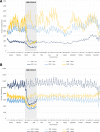Emergency department use during COVID-19 as described by syndromic surveillance
- PMID: 32948621
- PMCID: PMC7503196
- DOI: 10.1136/emermed-2020-209980
Emergency department use during COVID-19 as described by syndromic surveillance
Abstract
On 12 March 2020 the UK entered the 'delay phase' of the COVID-19 pandemic response. The Public Health England Emergency Department Syndromic Surveillance System (EDSSS) carries out daily (near real-time) public health surveillance of emergency department (ED) attendances across England. This retrospective observational analysis of EDSSS data aimed to describe changes in ED attendances during March-April 2020, and identify the attendance types with the largest impact. Type 1 ED attendances were selected from 109 EDs that reported data to EDSSS for the period 1 January 2019 to 26 April 2020. The daily numbers of attendances were plotted by age group and acuity of presentation. The 2020 'COVID-19' period (12 March 2020 to 26 April 2020) attendances were compared with the equivalent 2019 'pre-COVID-19' period (14 March 2019 to 28 April 2019): in total; by hour and day of the week; age group(<1, 1-4, 15-14, 15-44, 45-64 and 65+ years); gender; acuity; and for selected syndromic indicators(acute respiratory infection, gastroenteritis, myocardial ischaemia). Daily ED attendances up to 11 March 2020 showed regular trends, highest on a Monday and reduced in children during school holidays. From 12 March 2020 ED attendances decreased across all age groups, all acuity levels, on all days and times. Across age groups the greatest percentage reductions were seen in school age children (5-14 years). By acuity, the greatest reduction occurred in the less severe presentations. Syndromic indicators showed that the greatest reductions were in non-respiratory indicators, which fell by 44-67% during 2020 COVID-19, while acute respiratory infection was reduced by -4.4% (95% CI -9.5% to 0.6%). ED attendances in England have been particularly affected during the COVID-19 pandemic due to changes in healthcare seeking behaviour. EDSSS has enabled real-time daily monitoring of these changes, which are made publicly available to facilitate action. The EDSSS provides valuable surveillance of ED attendances in England. The flexibility of EDSSS allowed rapid development of new indicators (including COVID-19-like) and reporting methods.
Keywords: emergency department utilisation; epidemiology; infectious diseases; viral.
© Author(s) (or their employer(s)) 2020. Re-use permitted under CC BY. Published by BMJ.
Conflict of interest statement
Competing interests: TCH is a director of L2S2 Ltd.
Figures



Similar articles
-
Describing the indirect impact of COVID-19 on healthcare utilisation using syndromic surveillance systems.BMC Public Health. 2021 Nov 5;21(1):2019. doi: 10.1186/s12889-021-12117-5. BMC Public Health. 2021. PMID: 34740346 Free PMC article.
-
An Observational Study Using English Syndromic Surveillance Data Collected During the 2012 London Olympics - What did Syndromic Surveillance Show and What Can We Learn for Future Mass-gathering Events?Prehosp Disaster Med. 2016 Dec;31(6):628-634. doi: 10.1017/S1049023X16000923. Epub 2016 Sep 19. Prehosp Disaster Med. 2016. PMID: 27641930
-
Mental Health-Related Emergency Department Visits Among Children Aged <18 Years During the COVID-19 Pandemic - United States, January 1-October 17, 2020.MMWR Morb Mortal Wkly Rep. 2020 Nov 13;69(45):1675-1680. doi: 10.15585/mmwr.mm6945a3. MMWR Morb Mortal Wkly Rep. 2020. PMID: 33180751 Free PMC article.
-
Context: How COVID-19 exposed key factors of emergency medicine education.CJEM. 2020 Sep;22(5):561-562. doi: 10.1017/cem.2020.447. CJEM. 2020. PMID: 32962787 Review. No abstract available.
-
USNS COMFORT (T-AH 20) Surgical Services Response to the COVID-19 Pandemic in New York City.Ann Surg. 2020 Oct;272(4):e269-e271. doi: 10.1097/SLA.0000000000004320. Ann Surg. 2020. PMID: 32740240 Review. No abstract available.
Cited by
-
Impact of the COVID-19 pandemic on radiology department emergency ultrasound utilization.Emerg Radiol. 2021 Oct;28(5):869-875. doi: 10.1007/s10140-021-01936-z. Epub 2021 Apr 29. Emerg Radiol. 2021. PMID: 33914184 Free PMC article. Review.
-
Public Knowledge About Emergency Care-Results of a Population Survey From Germany.Front Public Health. 2022 Jan 7;9:787921. doi: 10.3389/fpubh.2021.787921. eCollection 2021. Front Public Health. 2022. PMID: 35071168 Free PMC article.
-
External validation of a low HEAR score to identify emergency department chest pain patients at very low risk of major adverse cardiac events without troponin testing.CJEM. 2022 Jan;24(1):68-74. doi: 10.1007/s43678-021-00159-y. Epub 2021 Jul 17. CJEM. 2022. PMID: 34273102
-
Impact of the COVID-19 pandemic on the unplanned patient flow in a Danish healthcare region, focusing on emergency departments: a multicentre cohort study.BMJ Open. 2025 Mar 3;15(3):e091124. doi: 10.1136/bmjopen-2024-091124. BMJ Open. 2025. PMID: 40032392 Free PMC article.
-
Lessons from COVID-19 syndromic surveillance through emergency department activity: a prospective time series study from western Switzerland.BMJ Open. 2022 May 6;12(5):e054504. doi: 10.1136/bmjopen-2021-054504. BMJ Open. 2022. PMID: 35523491 Free PMC article.
References
-
- Department of Health and Social Care COVID-19: government announces moving out of contain phase and into delay, 2020. Available: https://www.gov.uk/government/news/covid-19-government-announces-moving-... [Accessed 6 May 2020].
-
- NHS England Emergency care data set (ECDS), 2016. Available: https://www.england.nhs.uk/ourwork/tsd/ec-data-set/ [Accessed 6 May 2020].
-
- NHS Digital Emergency care data set (ECDS), 2020. Available: https://digital.nhs.uk/data-and-information/data-collections-and-data-se... [Accessed 6 May 2020].
-
- Public Health England Syndromic surveillance: systems and analyses: emergency department syndromic surveillance system, 2020. Available: https://www.gov.uk/government/collections/syndromic-surveillance-systems... [Accessed 4 May 2020].
MeSH terms
LinkOut - more resources
Full Text Sources
Miscellaneous
